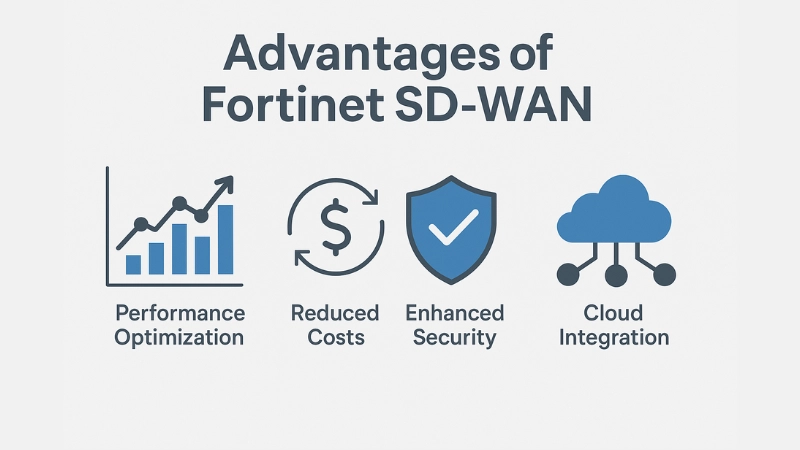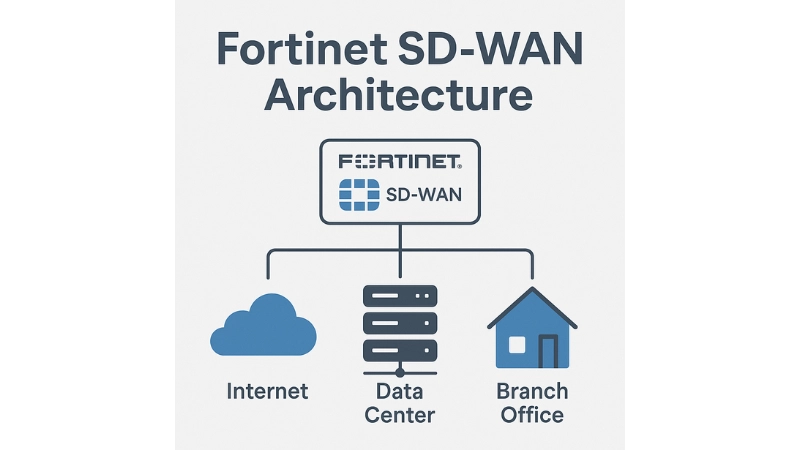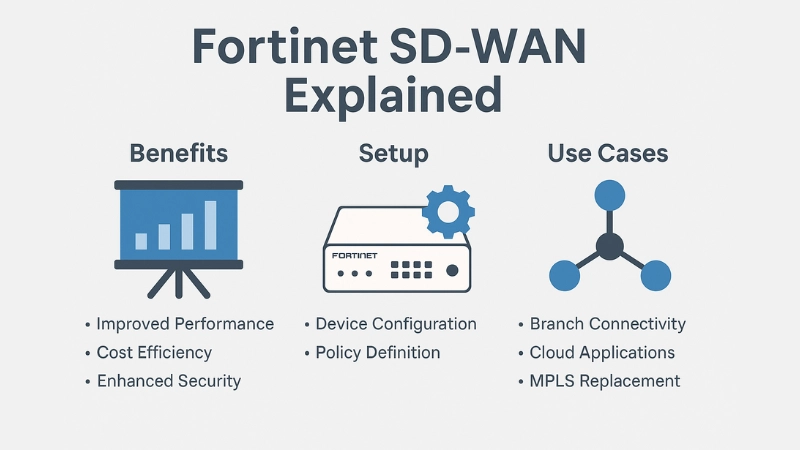Network security
Fortinet SD-WAN Explained: Benefits, Setup & Use Cases
As digital cloud services, remote access technologies, and video conferencing become more ingrained in business processes, traditional WANs are finding it increasingly difficult to keep pace. This is where SD-WAN, or software-defined wide area networking, comes to the rescue, as it redefines how organizations enable and manage their networks. Fortinet, well-recognized for its comprehensive cybersecurity products, is already paving the way with cybersecurity solutions such as FortiGate firewalls and their innovative SD-WAN gateway.
Via its SD-WAN solution, Fortinet SD-WAN offers integrated firewall security features with advanced traffic steering, delivering security and optimized, high-performance networking across branch offices, data centers, and even cloud environments. Unlike other SD-WAN providers which require manual third-party security integrations, Fortinet SD-WAN solutions come with an embedded NGFW (Next-Generation Firewall) security features which protects the business while offering simplified management.
First, explore the features and benefits of Fortinet SD-WAN. However, understanding the architectural benefits necessitates looking first at the business problem of why modern secure and optimized networking is at the core of today’s enterprises.
What Is SD-WAN and Why Does It Matter?
Conventional wide area networks (WANs) utilize fixed, private MPLS (Multiprotocol Label Switching) circuits for linking branch offices with a data center. MPLS, while secure, is costly and struggles to keep pace with cloud agility requirements. SD-WAN solves this problem with dynamic and heuristic-based traffic intelligent to fiber, LTE, and broadband networks.
With Fortinet SD-WAN, businesses get not only an intelligent but secure solution. This is critical because advanced threats demand more than basic firewall network perimeter defenses. Whether operating with a Fortinet Firewall for 300 users or managing a global Windows or Linux fleet of thousands of endpoints, integrated firewall features result in comprehensive visibility and policy enforcement at every security layer and architecure pivot.
Fortinet’s Take on SD-WAN
What makes Fortinet Secure SD-WAN unique is the security-driven networking approach instead of treating both networking and security as two different layers Fortinet integrates both of them. This is made possible with the FortiGate Firewall, which fortinet integrates SD-WAN, routing, NGFW firewall, and advanced threat protection in one device.
What makes Fortinet SD-WAN different is:
- Static security: Unlike SD-WAN vendors that rely on bolt-on security, Fortinet’s SD-WAN includes enterprise-grade firewall security out of the box.
- High Performance: Working with Fortinet appliances provides advanced security, as the devices come with special chips that enhance the firewall, even while performing deep inspection functions such as intrusion prevention and antivirus scanning.
- Scalability: Fortinet range from the Fortinet Firewall for 300 users to large scale deployments, giving strartup and small privados to distrubuted enterprise prescense fortinet provides range to different users.
All these factors, along with ease of use, make SD-WAN powerful, secure, and simple fortinet users find firewall protection US without incraesing cost and complexity of the device.
Notable Advantages of Fortinet SD-WAN

- Cost Efficiency
Organizations can now eliminate or reduce reliance on costly MPLS connections. Utilizing public broadband or LTE connections allows significant reduction to WAN costs for companies.
- Application-Aware Routing
Traffic prioritization is one of the defining aspects of SD-WAN. Fortinet’s solution makes sure applications like Zoom, Microsoft Teams, or Salesforce are routed through the best available link, dynamically ensuring optimal performance during congestion.
- Integrated Security
With Fortinet, companies need not purchase a separate Network firewall. The Built-in NGFW capabilities offers:
- Intrusion prevention
• Antivirus and anti-malware
• Application control
• Web filtering
Such features make Fortinet SD-WAN a strong security solution, and also illustrates the benefits of firewall security for cloud-first enterprises.
- Centralized Management
With thousands of branch locations, administrators can use FortiManager and FortiAnalyzer for single pane of glass visibility and policy management. This greatly enhances efficiency for executing policies, tracking performance, and auditing logs.
Fortinet SD-WAN Architecture

Knowing the architecture of Fortinet SD-WAN can assist IT teams in making better deployment decisions. In general, the architecture needs to be modular, secure, scalable, and adhere to the Fortinet SD-WAN components:
🔷 FortiGate Firewall
Wind at the core of Fortinet SD-WAN is the FortiGate Firewall, a rest endpoint that consolidates routing, firewall, SD-WAN and VPN functions. It enforces policies both to incoming and outgoing traffic using inspection, and protects against various forms of threats.
🔷 Secure Overlay Network
Fortinet utilizes IPsec tunnels as a means of constructing a secure waterfall SD-WAN overlay. These tunnels secure all data travelling across public and private links.
🔷 FortiManager
Allows network teams to perform configuration, monitoring, and troubleshooting on all FortiGate devices. For enterprises with dozens or hundreds of branches, this central management console improves operations.
🔷 FortiAnalyzer
Helps to monitor bandwidth, check link health and application performance using sophisticated analytics and reporting, Link bandwidth, active application performance, and heuristic examination.
🔷 Link Monitoring and SLA Enforcement
Fortinet architecture incorporates SLA measurement tools for monitoring and measuring metrics such as latency, jitter, and packet loss. These metrics enable the shifting of traffic dynamically for critical application performance maintenance.
Such architecture is integrated to enable support on diverse business scenarios such as a single branch office or complex multi-site and global enterprises
How to Set Up Fortinet SD-WAN (Step-by-Step)
The Fortinet SD-WAN is easier to set up for organizations with existing Fortinet Firewall or FortiGate Firewall. Merging security with performance is the primary intention as it reduces bulk simplifies the process and improves visibility for the user.
🔹 Step 1: Confirm Prerequisites
Make sure to check if your FortiGate devices support SD-WAN. You need the following:
- FortiOS 6.2 or newer
- Active Fortinet SD-WAN license (may be included)
- Minimum of 2 internet sources (broadband, MPLS, LTE)
For mid-sized businesses (about 300 users), FortiGate 100F or 200F Firewalls give ideal value for investment as they provide good throughput balance, firewall security, SD-WAN optimization, and throughput.
🔹 Step 2: Define WAN Interfaces
Add the WAN interfaces (like WAN1, WAN2, LTE, etc.) to the SD-WAN that you wish to include. Go to the FortiGate dashboard and click on Network> SD-WAN to log in.
- Set interface roleSLAs
- Set performance SLAs for all links
- Configure health checks (latency, jitter, and packet loss)
🔹 Step 3: Create Performance SLAs
Set border limits to application performance. Fortinet will be able to monitor the SLAs that were defined and will proactively or passively reroute traffic to a backup connection in the event that one connection fails or offers subpar performance.
Example SLAs:
- Latency Less than 150ms
- Jitter Less than 20ms
- Loss of Packets Less than 2%
🔹 Step 4: Set Up SD-WAN Rules
As the next step, set up traffic routing rules. Fortinet supports application-aware routing, so they can manage traffic prioritization for Zoom, Teams, or VoIP over video streaming or bulk downloads.
Rule types:
- Manual: Static route based on link preference
- Best Quality: Fortinet selects the link with the best SLA at that time
- Lowest Cost: Traffic routed based on the least expensive link available
These rules allow controlling network traffic. The rules enhance firewall security by controlling data flow and preventing bandwidth abuse for critical apps. It is particularly helpful for managing network traffic and remote work.
🔹 Step 5: Turn on Profiles Security
Despite the importance of optimized routing, firewall security is critical. Apply NGFW firewall profiles to inspect and manage all traffic:
- Web Filtering
- Intrusion Prevention (IPS)
- Antivirus and Anti malware
- Control of Applications
This ensures the benefits of firewall security extend to all WAN paths, not just to traditional links.
🔹 Step 6: Monitor and Troubleshoot with FortiView
Use FortiAnalyzer or FortiGate’s built-in FortiView to gain deep visibility into link performance, traffic flows, threats, and bandwidth utilization. Alerts can be configured for SLA violations, security events, or interface drops.
By integrating monitoring into a network firewall infrastructure, Fortinet reduces complexity and centralizes diagnostics.
Real-World Use Cases
Retail outlets usually work in constrained environments. Fortinet SD-WAN allows these branches to:
- Substitute/MPLS with broadband.
- Protect their payment systems with Fortinet Firewall.
- Integrated firewall security helps maintain PCI compliance.
🏥 Healthcare Providers
SD-WAN improves telehealth and EHR applications in clinics and hospitals. Patient information is protected with Fortinet’s HIPAA-compliant NGFW firewall.
🏦 Banking & Financial Services
SD-WAN automates ATMs, trading platforms, and VoIP telephone systems ensuring high uptime. Financial data is protected from intrusion, phishing, and ransomware by FortiGate Firewall enforcement.
🎓 Educational Institutions
From K-12 to higher education, remote learning is supported through Fortinet SD-WAN, and granular control is enabled over Youtube, Google Meet, and cloud drives at the firewall level.
Common Challenges and Fortinet’s Solutions
| Challenge | Fortinet SD-WAN Solution |
| High MPLS costs | Uses affordable broadband + LTE with SD-WAN routing |
| Inconsistent app performance | SLA-based path selection with automatic failover |
| Disparate security tools | Unified firewall + SD-WAN in a single FortiGate Firewall |
| Limited visibility into WAN performance | Centralized logging and analytics via FortiAnalyzer |
| Remote configuration headaches | Zero-touch provisioning and cloud-managed setup |
These solutions embody the benefits of firewall security in a modern, scalable way.
Conclusion
Beyond being a mere network optimization tool, Fortinet’s SD-WAN functions as a security-centric firewall with full routing capabilities, offering high-performance routing and comprehensive protection. Dependent on the scenario, be it overseeing remote locations, cloud applications, or hybrid structures, Fortinet’s SD-WAN solution integrated with NGFW firewall features stands as one of the most secure and cost-effective on the market.
Offering solutions for a medium-sized business—such as a Fortinet Firewall for 300 users—up to large-scale enterprises, Cost to Cost delivers Fortinet-powered SD-WAN with the security, control, and flexibility required by digitally transformed organizations.
Frequently Asked Questions
1. What is firewall and how does it work with SD-WAN?
A firewall is an example of a network security device which enforces rules for traffic to monitor and control network traffic. For Fortinet SD-WAN, the firewall is integrated and traffic is monitored during routing, which removes the need for separate security appliances
2. Can Fortinet Firewall support over 300 users with SD-WAN?
Models such as FortiGate 100F, and above, are capable of supporting hundreds of users as they are equipped with SD-WAN. The Fortinet firewall for 300 users is perfect for an expanding company as it contains features such as high-throughput inspection, VPN, and load balancing.
3. Is Fortinet SD-WAN secure enough for regulated industries?
Of course. SD WANs are equipped with integrated NGFW firewall, application control, and encrypted VPN, which enables Fortinet to comply with industry regulations such as HIPAA and PCI-DSS.
4. Do I still need MPLS with Fortinet SD-WAN?
Not really. With Fortinet SD WAN, it is possible to mix and match WAN types, using broadband, LTE, and others. A lot of companies are able to remove or reduce the amount of MPLS used after the implementing SD WAN.


























































